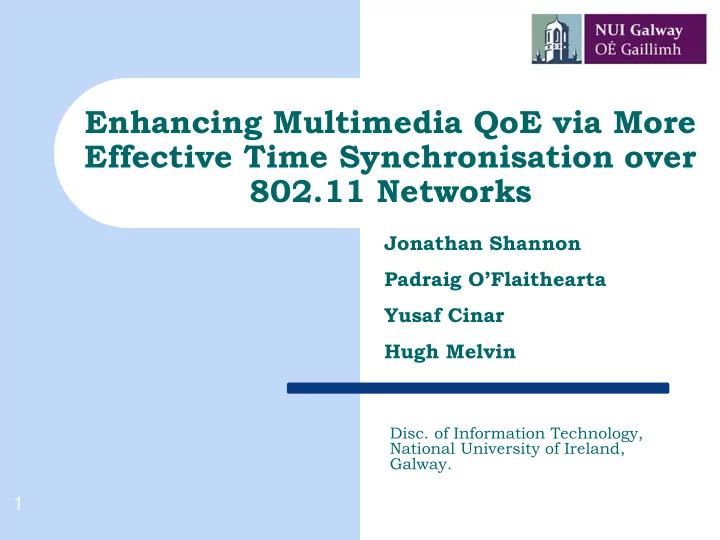

Enhancing Multimedia QoE via More Effective Time Synchronisation over 802.11 Networks Jonathan Shannon Padraig O’Flaithearta Yusaf Cinar Hugh Melvin Disc. of Information Technology, National University of Ireland, Galway. 1
Outline Multimedia & Synchronisation Computer Clocks, Synchronisation Terminology & Techniques 802.11, NTP & Issues Simulations Delay Determination Technique Experiments & Results Questions 2
Growing Role of Synchronisation VoIP (Voice over IP) 3
Growing Role of Synchronisation MMOG (Massive Multiplayer Online Game) 100 ms Game Server 20 ms 10 ms 5 ms 4
WebRTC WebRTC Open source project released by Google in 2011 • Aim to equip browsers with RTC capabilities • W3C standardising ECMAscript API’s • IETF standardising underlying RTC protocols (Rtcweb WG) • WebRTC & VoIP Techniques to cope with variable packet latencies (Jitter • buffer and play-out strategy algorithms) WebRTC NetEQ component • NetEQ can benefit from packet delay information – improve • QoS Synchronisation of wireless nodes important • 5
System Clock Operation 6
Synchronisation Terminology Host & Reference Offset Time difference between a host time and a reference time Indication of clock accuracy Denoted by 𝜄 Skew Rate of change of host’s time with respect to reference’s time Influenced by oscillator precision/accuracy Denoted by 𝜇 Drift Rate of change of host’s skew with respect to reference’s time Influenced by oscillator stability 7 Denoted by 𝜒
Sources of Synchronisation Error Send Time Timestamp, construct message & send to NIC (system load, system call latencies) Access Time Access communication medium (MAC rules) Propagation Time Traverse link between sender and receiver Receive Time NIC receive & decode time and time 8 interval before timestamp
Synchronisation Techniques Uni-directional Synchronisation Host sets its time to the value received in a time message from a reference Round-trip Synchronisation Two-way message exchange Host obtains timestamps 𝑼 𝒋 , 𝑼 𝒋+𝟐 , 𝑼 𝒋+𝟑 and 𝑼 𝒋+𝟒 Determines round-trip delay ( 𝜀 ) and offset ( 𝜄 ) 𝜀 = ( 𝑼 𝒋+𝟒 − 𝑼 𝒋 ) − ( 𝑼 𝒋+𝟑 − 𝑼 𝒋+𝟐 ) 9 𝜄 = ( 𝑼 𝒋+𝟐 − 𝑼 𝒋 ) + ( 𝑼 𝒋+𝟑 − 𝑼 𝒋+𝟒 ) 𝟑
Synchronisation in WiFi Networks Offset A = 𝑼 𝒋+𝟐 − 𝑼 𝒋 𝐂 = 𝑼 𝒋+𝟒 − 𝑼 𝒋+𝟑 𝜄 = ( 𝑼 𝒋+𝟐 − 𝑼 𝒋 ) − (𝑼 𝒋+𝟒 − 𝑼 𝒋+𝟑 ) 𝟑 WiFi/802.11 Access & buffer delays NTP Degrade performance 10
Up-link & Down-link Delays 11
Simulations – NS3 12
Simulations – NS3 13 𝛝 = ( 𝒗𝒒𝒎𝒋𝒐𝒍 ) − ( 𝒆𝒑𝒙𝒐𝒎𝒋𝒐𝒍 ) 𝟑
Simulations – NS3 14
Solution 15
Up-link Delay ( Δ u ) Determination 16
Down-link Delay ( Δ d ) Estimation 17
Down-Link Delay Estimation 18
Experiment – Real Test-Bed How effective is it? NTP client sends 20 NTP packets per minute A & B transmit TCP packets to each other via AP Create load at AP - induce large buffer delays Duration 60 mins 19
Traffic 20
Up-Link Delays 21
Down-Link Delays 22
Results – Offsets ( θ ) & Errors ( ε ) 23
Error Distribution ( ε U ) (un-corrected)
Error Distribution ( ε C ) (corrected)
Outcome Module/Technique – reduces synchronisation errors in 802.11 networks Can be used on any host with Protocol that uses uni-directional or round-trip synchronisation NIC that supports packet injection Results indicate up to 90% reduction in average offset errors Improve quality of dataset provided to time protocols 26
References P. O. Flaithearta, H. Melvin, and P. Pocta. Time awareness in software defined networking . European Conference on Networks and Communications, 2015. P. O Flaithearta, H. Melvin, and M. Schukat. A qos enabled multimedia wifi access point. International Journal of Network Management, 25(4):205 – 222, 2015. Y. Cinar, H. Melvin, and P. Pocta. A black-box analysis of the extent of time-scale modification introduced by webrtc adaptive jitter buffer and its impact on listening speech quality. Special Issue of Communications journal (Scopus) on Telecommunications Beyond, 2016. 27
Questions 28
Recommend
More recommend